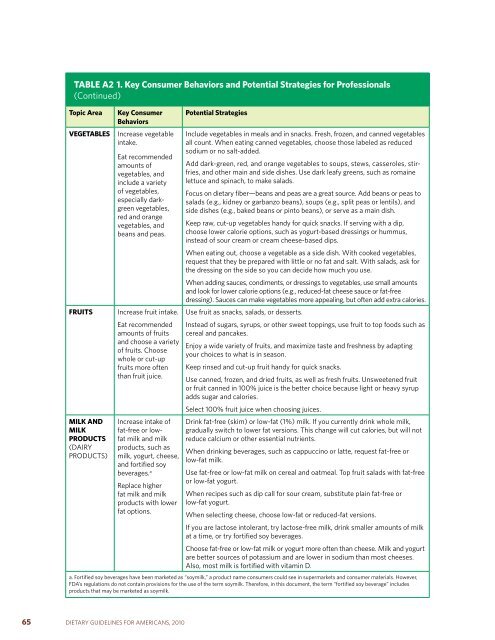Dietary Guidelines for Americans - SchoolNutritionAndFitness.com
Dietary Guidelines for Americans - SchoolNutritionAndFitness.com
Dietary Guidelines for Americans - SchoolNutritionAndFitness.com
- No tags were found...
Create successful ePaper yourself
Turn your PDF publications into a flip-book with our unique Google optimized e-Paper software.
taBle a2 - 1. key consumer Behaviors and Potential strategies <strong>for</strong> Professionals(Continued)topic areavegetaBlesfruitsMilk andMilkProducts(DAIRYPRODUCTS)key consumerBehaviorsIncrease vegetableintake.Eat re<strong>com</strong>mendedamounts ofvegetables, andinclude a varietyof vegetables,especially darkgreenvegetables,red and orangevegetables, andbeans and peas.Increase fruit intake.Eat re<strong>com</strong>mendedamounts of fruitsand choose a varietyof fruits. Choosewhole or cut-upfruits more oftenthan fruit juice.Increase intake offat-free or lowfatmilk and milkproducts, such asmilk, yogurt, cheese,and <strong>for</strong>tified soybeverages. aReplace higherfat milk and milkproducts with lowerfat options.Potential strategiesInclude vegetables in meals and in snacks. Fresh, frozen, and canned vegetablesall count. When eating canned vegetables, choose those labeled as reducedsodium or no salt-added.Add dark-green, red, and orange vegetables to soups, stews, casseroles, stirfries,and other main and side dishes. Use dark leafy greens, such as romainelettuce and spinach, to make salads.Focus on dietary fiber—beans and peas are a great source. Add beans or peas tosalads (e.g., kidney or garbanzo beans), soups (e.g., split peas or lentils), andside dishes (e.g., baked beans or pinto beans), or serve as a main dish.Keep raw, cut-up vegetables handy <strong>for</strong> quick snacks. If serving with a dip,choose lower calorie options, such as yogurt-based dressings or hummus,instead of sour cream or cream cheese-based dips.When eating out, choose a vegetable as a side dish. With cooked vegetables,request that they be prepared with little or no fat and salt. With salads, ask <strong>for</strong>the dressing on the side so you can decide how much you use.When adding sauces, condiments, or dressings to vegetables, use small amountsand look <strong>for</strong> lower calorie options (e.g., reduced-fat cheese sauce or fat-freedressing). Sauces can make vegetables more appealing, but often add extra calories.Use fruit as snacks, salads, or desserts.Instead of sugars, syrups, or other sweet toppings, use fruit to top foods such ascereal and pancakes.Enjoy a wide variety of fruits, and maximize taste and freshness by adaptingyour choices to what is in season.Keep rinsed and cut-up fruit handy <strong>for</strong> quick snacks.Use canned, frozen, and dried fruits, as well as fresh fruits. Unsweetened fruitor fruit canned in 100% juice is the better choice because light or heavy syrupadds sugar and calories.Select 100% fruit juice when choosing juices.Drink fat-free (skim) or low-fat (1%) milk. If you currently drink whole milk,gradually switch to lower fat versions. This change will cut calories, but will notreduce calcium or other essential nutrients.When drinking beverages, such as cappuccino or latte, request fat-free orlow-fat milk.Use fat-free or low-fat milk on cereal and oatmeal. Top fruit salads with fat-freeor low-fat yogurt.When recipes such as dip call <strong>for</strong> sour cream, substitute plain fat-free orlow-fat yogurt.When selecting cheese, choose low-fat or reduced-fat versions.If you are lactose intolerant, try lactose-free milk, drink smaller amounts of milkat a time, or try <strong>for</strong>tified soy beverages.Choose fat-free or low-fat milk or yogurt more often than cheese. Milk and yogurtare better sources of potassium and are lower in sodium than most cheeses.Also, most milk is <strong>for</strong>tified with vitamin D.a. Fortified soy beverages have been marketed as “soymilk,” a product name consumers could see in supermarkets and consumer materials. However,FDA’s regulations do not contain provisions <strong>for</strong> the use of the term soymilk. There<strong>for</strong>e, in this document, the term “<strong>for</strong>tified soy beverage” includesproducts that may be marketed as soymilk.65DIETARY GUIDELINES FOR AMERICANS, 2010

















